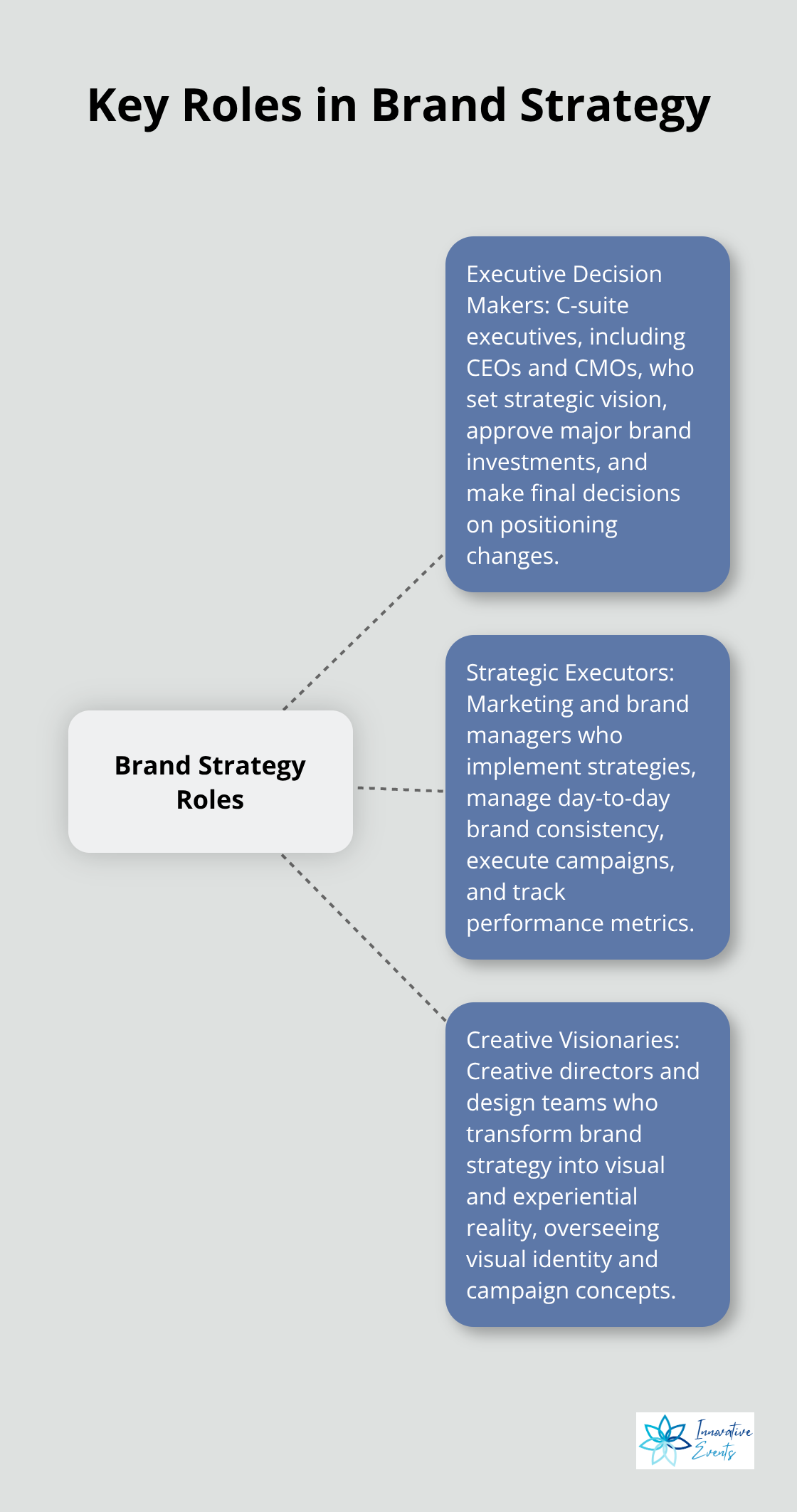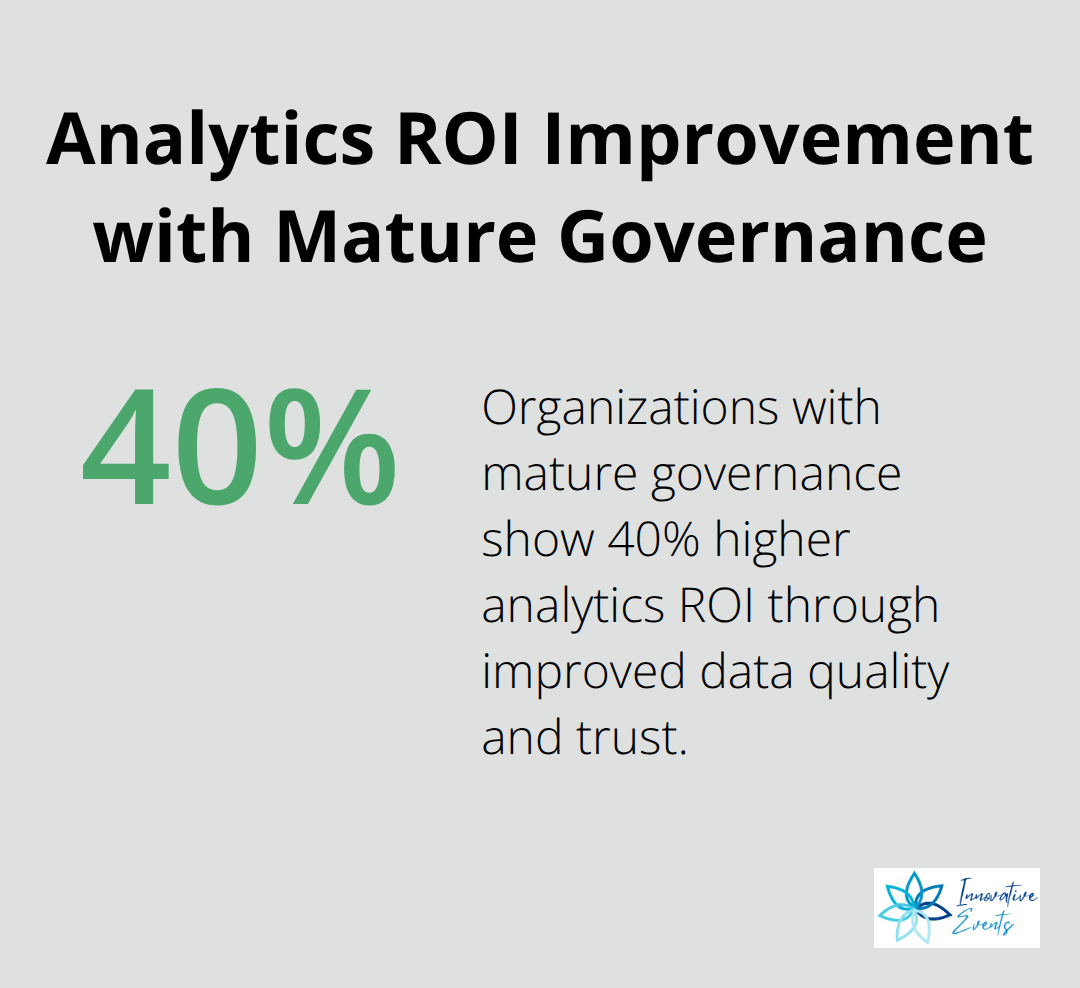Building a winning brand requires more than great ideas-it demands the right people in the right positions. Brand strategy roles span multiple departments, from executive leadership to creative teams.
At Innovative Events, we’ve seen how proper role definition transforms brand development from chaotic guesswork into strategic success. The difference lies in understanding who does what and when.
Who Makes Brand Strategy Decisions
The Executive Decision Makers
C-suite executives hold the ultimate authority in brand strategy development, but their involvement varies dramatically based on company size and structure. CEOs drive transformation and growth through strategic decision-making, focusing on enterprise success and organizational change. They set the strategic vision, approve major brand investments, and make final calls on position changes.
The most successful executives delegate tactical execution while they maintain oversight of brand performance metrics. Chief Marketing Officers serve as the bridge between executive vision and operational reality. They translate high-level brand goals into actionable roadmaps, control budget allocation, and approve campaigns while they coordinate cross-departmental efforts.
The Strategic Executors
Marketing and brand managers function as the operational backbone of brand strategy implementation. These professionals manage day-to-day brand consistency, campaign execution, and performance tracking. Brand managers at consumer goods companies typically oversee 3-5 product lines simultaneously (which requires exceptional project management skills).
They coordinate with agencies, manage creative briefs, and monitor brand health metrics like awareness and sentiment scores. Marketing managers focus on channel strategy and campaign optimization. They often manage budgets that range from $100,000 to $2 million annually. Their success depends on how well they balance creative vision with data-driven results.
The Creative Visionaries
Creative directors and design teams transform brand strategy into visual and experiential reality. Top creative directors command salaries that exceed $200,000 because they directly impact brand perception and customer engagement. They oversee visual identity development, campaign concepts, and brand guideline creation.
Design teams execute these concepts across touchpoints, from packaging to digital experiences. The most effective creative teams maintain brand consistency while they adapt messages for different audiences and channels. Their work directly influences conversion rates, particularly considering how price impacts consumer behavior and digital strategy decisions.

These roles work most effectively when they understand their specific responsibilities and maintain clear communication channels with other team members.
Essential Skills and Expertise Required
Strategic Market Analysis Foundation
Brand strategy success depends on three non-negotiable skill sets that separate effective teams from those that waste resources on misguided campaigns. Market analysis expertise stands as the foundation and requires professionals who can interpret consumer behavior data and competitive intelligence.

Organizations with mature governance show 40% higher analytics ROI through improved data quality and trust. Strategic thinkers must translate market research into actionable positioning recommendations, identify white space opportunities, and predict consumer trend shifts before they become mainstream.
The most valuable team members combine analytical rigor with business acumen. They understand how brand decisions impact profit margins and market share while they maintain focus on long-term growth objectives.
Creative Vision and Brand Storytelling
Creative storytelling capability transforms data insights into compelling brand narratives that resonate with target audiences. Top creative professionals command premium salaries because they generate measurable engagement improvements across all touchpoints.
Research shows that perceived artificial creativity influences consumer purchase intentions through AI quality and advertising pathways. Effective brand storytellers craft messages that connect emotionally while they maintain consistency across channels and platforms.
These professionals excel at visual identity development, campaign concept creation, and brand guideline establishment. Their work directly influences conversion rates and customer retention metrics (particularly in competitive markets where differentiation matters most).
Data Analysis and Consumer Insights
Consumer insight specialists bridge the gap between creativity and strategy through behavioral analysis, focus group research, and sentiment tracking. These professionals identify the psychological triggers that drive purchase decisions and brand loyalty patterns.
Data analysts within brand teams focus on performance metrics, attribution modeling, and ROI measurement. They track brand health indicators like awareness scores, sentiment analysis, and competitive positioning shifts. Teams that master all three skill areas create brand strategies that generate sustainable competitive advantages.
The integration of these capabilities becomes even more important when teams must coordinate across departments and maintain alignment on strategic objectives.
How Brand Teams Coordinate Daily Work
Cross-functional brand teams fail when they operate in silos, yet 73% of organizations struggle with departmental alignment according to McKinsey research. The solution requires structured coordination systems that eliminate communication gaps and role confusion. Teams that implement weekly cross-departmental standups see improved problem-solving capabilities and enhanced innovation compared to those that rely on email updates alone.

Communication Rhythms That Work
Brand teams need three distinct communication frequencies to maintain momentum. Daily check-ins between creative and strategy teams prevent misaligned deliverables, while weekly stakeholder reviews catch strategic drift before campaigns launch. Monthly executive briefings keep leadership informed without micromanagement of tactical decisions.
Companies like Procter & Gamble use this rhythm structure across their brand portfolio, which results in consistent messages and reduced campaign revisions. The key lies in matching meeting frequency to decision urgency rather than defaulting to weekly everything.
Documentation Creates Accountability
Clear role documentation eliminates the blame game when projects stall. Brand managers should own campaign performance metrics, creative directors control visual consistency standards, and executives approve strategic pivots above predetermined budget thresholds.
Teams that document decision rights reduce project delays because everyone knows who makes what calls when conflicts arise. This documentation must live in accessible systems where all team members can reference current responsibilities and escalation paths (without hunting through email chains or shared drives).
Metrics That Matter for Collaboration
Track collaboration effectiveness through cycle time metrics, revision counts, and stakeholder satisfaction scores rather than subjective team harmony assessments. High-performance brand teams complete campaigns faster because they resolve conflicts through data rather than politics.
When teams measure coordination success objectively, they identify bottlenecks quickly and adjust processes before major delays impact market timing. The most effective teams review these metrics monthly and make process adjustments based on performance trends (not personal preferences or departmental politics).
Final Thoughts
Brand strategy roles determine whether your organization builds market-leading recognition or wastes resources on disconnected campaigns. Companies that define clear responsibilities across executive, marketing, and creative functions see measurable improvements in campaign performance and brand consistency. The evidence shows that structured coordination systems eliminate the communication breakdowns that plague 73% of organizations.
C-suite executives must focus on strategic vision while marketing managers handle tactical execution, and creative teams maintain visual consistency. Teams need documented decision rights, regular communication rhythms, and performance metrics that track collaboration effectiveness rather than subjective harmony assessments. Success requires more than talented individuals (it demands systematic coordination across all brand functions).
At Innovative Events, we help organizations build the structured teams necessary for long-term brand growth through our comprehensive approach to event marketing and brand experiences. Start by auditing your current brand strategy roles and documenting decision-making authority. Implement weekly cross-departmental coordination meetings to create the framework for brand teams that deliver consistent results.

